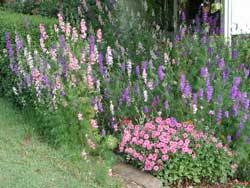Resource Library
Plant of the Week: Larkspur
The University of Arkansas System Division of Agriculture does not promote, support or recommend plants featured in "Plant of the Week." Please consult your local Extension office for plants suitable for your region.
Plant of the Week
Larkspur
Latin: Consolida ajacis

Late spring is a time of transition in the garden. The showy spectacle of springtime bloom is over and the summer annuals have not yet filled in to provide the backdrop of color for the warm months. It’s during this period that larkspur (Consolida ajacis) provides a rich palette of color to fill the void.
Larkspurs are winter annuals closely related to their perennial cousins, the Delphiniums. These tough, easy-to-grow annuals have a decidedly erect habit of growth with strong stems growing about 3 feet tall. This species, in its wild form, has only a single stem and is the "rocket" larkspur, whereas most of the branched hybrids incorporate genes from the branched larkspur, C. regalis. Larkspur foliage is deeply dissected and lacy.
Flowers are in shades of blue, violet, pink or white and appear up the stems during the last days of spring. Both single and double forms are available. In northern areas, larkspurs will bloom during the summer season, but in southern gardens most of the display is concentrated in May and June.
The showy parts of the flower are the five sepals with the true petals reduced to a small cluster in the center of the bloom. A long, nectary spur protrudes backwards from the flower and serves as an enticement for visiting pollinators. Delphiniums belong to the buttercup family.
Three species of larkspurs were introduced into English gardens from Italy between 1550 and 1573. They became instant hits and were frequently used in the first wave of pleasure gardens built during this period. They were introduced into American gardens during the pre-Revolutionary era.
As with most plants grown in gardens during this period, gardeners experimented with them to find medicinal uses. Larkspur was thought to strengthen eyesight, being so effective that even looking at them was said to improve vision. Who would need a better excuse for growing these showy annuals?
Whereas delphiniums have a reputation for being difficult to grow, larkspurs are considered easy - some would even say weedy. They produce copious amounts of seed and can become a permanent part of the garden, reseeding freely each year. Any unwanted seedlings are easily removed or relocated.
In southern gardens, larkspur seeds are best planted in September and October for spring bloom. When planting scatter seeds thinly in open areas in a fertile, uniformly moist bed. They must have full sun.
Larkspur is a natural for including amongst bulb plantings, as a companion to roses or in the perennial border where gaps periodically occur. They also make good cut flowers.
By: Gerald Klingaman, retired
Extension Horticulturist - Ornamentals
Extension News - June 12, 2009
The University of Arkansas System Division of Agriculture does not maintain lists of retail outlets where these plants can be purchased. Please check your local nursery or other retail outlets to ask about the availability of these plants for your growing area.